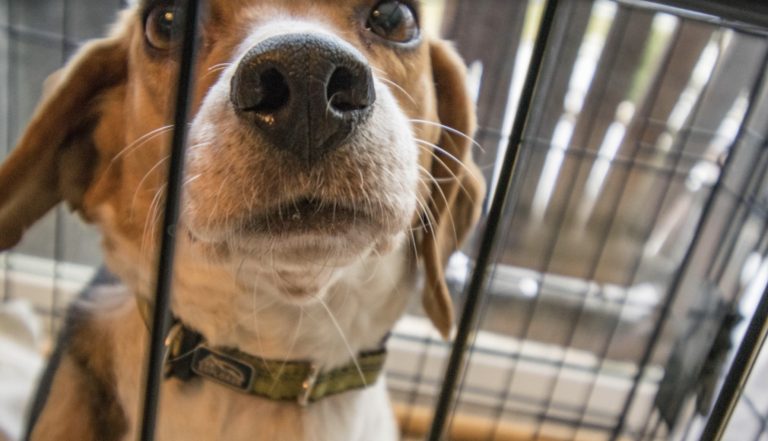Crate training dog is not an easy task. Anyone who has tried it will tell you. But if you are consistent in your dog training and crate training process, you can succeed. Today, we will talk about how you can use crate training games.
They are a fantastic way to teach your dog to run in and out of the crate on your command. And it doesn’t matter if you have plastic crates or wire crates.
Basic Guidelines
Before we get to the crate training a puppy process, let’s talk about some basic guidelines and principles for how to play these games.
- First and foremost, keep your dog training sessions short and fun
- Always use a release word like free or okay to let your dog know he can come out of the crate. Put a little energy into saying the release word
- Train when you and your puppy are in a good mood. If one of you is not feeling happy, there will be no success. Your dog can sense you are not happy. So do not train
- Do not turn crate training dog process into a grind. A couple of short sessions are enough
- Play each game for several days before trying something new. Concepts of these games build on each other
Best Games to play
Playing games is always fun. And learning new things through fun is a guaranteed success. Ask any dog trainer, and he will tell you that without making things fun, there is no success.
So, with that in mind, here are some games dog owners can try to train a puppy.
Crate is cool
Start with a game that will teach your puppy that the dog crate is cool. With the crate door open, sprinkle some treats outside the door and inside the crate.
Let your young puppy eat the treats and then toss a couple more all the way to the back of the crate. Once your dog goes all the way inside in the puppys crate, you are ready to move to the next game.
If not, play this game a few more times. At this stage, you should not close the crate door.
Stay a while
The next game will build awareness in your new puppy about a hand signal for going into the crate. You can practice swinging your hand with the finger pointing while throwing a treat with that hand.
Yes, it will feel awkward in the beginning. But it becomes natural with some crate train practice. This motion should look like you are telling your young puppy or adult dog to go where you are pointing.
When you master the motion, stand beside the open door, and toss a treat far inside the crate. Your dog should follow the treat. If it doesn’t, go back to the previous game. If your puppy follows the treat, toss another far inside.
Keep throwing treats as your puppy eats them. Ideally, your dog should look at you and wait for another treat rather than trying to leave the crate.
Time to add a cue
With the next game, you want to add a crate cue. Stand by the open crate like in the previous game, and add the crate cue before pointing and throwing the treat.
Say the word before you move. This way, your puppy understands the meaning of the word. This time, throw treats behind your puppy and let him eat. Using positive reinforcement, you reinforce how good it is to stay inside. Add a release word and encourage your puppy to come out.
Repeat several times and see whether your puppy goes happily inside and comes out.
Wait for permission
At this point, you should be in the middle of the crate training process. You can now put your dog inside, and start working on permission to get out.
Send your dog into the crate, which is a safe place, and then give a couple of treats for going in. Stand back and wait to see what your dog will do.
If your new dog waits for more treats, toss another one inside and wait. If he tries to run out of the crate, go back to the previous game and continue until your puppy stays inside and waits for treats.
Wait for a few seconds before tossing a new treat. This will let your dog know that it is you who gives permission to come out.
Closing the door
When you can close the door? Well, it takes time. Do it slowly and make it fun. Wait until your dog is comfortable staying inside the crate.
Try to close the door. See how your puppy reacts? Is your new dog whining? Or is he staying inside in a calm behavior?
Gradually increase the time you keep the door closed. As you extend the time, add more treats through the closed door.
Do not give your puppy a treat or open the door is he is whining or fussing. Ignore him and wait for calm behavior. This way, you reinforce positive behavior.
Say Please
At this point, you are almost finished with the crate train process. You just need to add a command or cue for your dog to get out.
To let your dog outside of the crate, ask him to sit or lie down. This will teach your dog that to get outside of the crate, it needs to show good behavior.
If your dog tries to break the behavior, correct him and lure him using a treat. For sitting it is quite easy. Put the tasty treat above your dog’s head.
Pros and Cons of Crate Training
Today, we talked about some games you can play to get your dog to love its crate. We played with treats, but you can always do crate train exercises with a stuffed toy, chew toy, or anything else. Why do you need crate training.
Pros:
- Crate training is convenient
- It helps with an over-excited dog to calm it down
- Prevents destructive behavior like chewing
- It fosters den instincts, reducing possessiveness in your puppy
- Great for house training and housebreaking
- You can utilize the crate for potty training
Cons:
- Can cause physical harm if your dog spends too much time in it
- Can cause stress on the limbs if your dog is unable to move around
- Dogs can become distressed
- It can cause agitation and you cannot overcome it with crate training
Things to remember
Some final words about crate training dog. You really need to be dedicated and consistent in your journey. Remember, each dog is different. Focus on the end results, not on the time and energy you put into the dog training. And keep these things in mind:
- Do not leave your dog inside for long periods
- Refrain from associating the crate with punishment
- Choose the right crate size to allow your pet to have comfort






